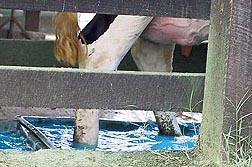A Cautionary Note About Copper Footbaths for Dairy Cows
At least once a day, many of Idaho’s 550,000 dairy cows wade through shallow copper sulfate baths to help prevent foot infections. Producers often discard the bath water into lagoons and eventually use the spent wastewater to irrigate corn and alfalfa.
“At some point, the buildup of copper in the soil could start to negatively affect crop production,” says soil scientist Jim Ippolito, who works at the Agricultural Research Service’s Northwest Irrigation and Soils Research Laboratory in Kimberly, Idaho. “By studying this issue now, we may be able to help producers develop irrigation management strategies that keep copper from getting to potentially harmful levels.”
Ippolito joined with ARS soil scientist David Tarkalson and microbiologist Tom Ducey to study how copper levels in the wastewater affected crop performance and soil microbial activities. Tarkalson also works in Kimberly, and Ducey is with ARS’s Coastal Plains Soil, Water, and Plant Research Center in Florence, South Carolina.
The scientists selected two soils common to south-central Idaho, where many dairies are located. Then they conducted a lab study of alfalfa growth in soils containing copper at levels of 50 parts per million (ppm), 100 ppm, 250 ppm, 500 ppm, or 1,000 ppm.
Copper sulfate at soil levels of up to 250 ppm had no effect on alfalfa growth, but alfalfa growth stopped when soil copper sulfate levels exceeded 500 ppm. The alfalfa plants took up higher levels of copper at both application rates, and from 48 to 80 percent of the added copper was still in the soil and available to plants at the end of the study.
The team also discovered that beneficial soil bacterial activity declined when the two soils accumulated available soil copper levels above 50 ppm. And a correlation analysis indicated that soil levels above 63 ppm of plant-available copper resulted in alfalfa copper concentrations that could potentially harm grazing livestock, according to guidelines established by the National Research Council.
Ippolito also conducted a laboratory study of whether biochar made from pecan shells could reduce copper levels in the spent wastewater. He tested the biochar in solutions with varying pH levels and found that the amount of copper adsorbed, or “captured,” by the biochar could be as much as 40,000 ppm. He concluded that it might be possible to use biochar to clean up waters containing elevated copper levels, but that more studies would be needed to identify characteristics that would allow the biochar to capture the most copper.
Ippolito published his findings in the Journal of Agricultural Science, Soil Science, and the Journal of Environmental Quality.
“In our studies, we controlled how much copper was added to the soil. But in real-world conditions, soil copper accumulations and their effects will vary depending on a range of factors, including how often crops are irrigated, how much copper is in the wastewater, and how much copper remains in plant-available form,” Ippolito says. “We might not see any negative impacts for anywhere from 15 to 75 years after irrigation begins. But producers should be proactive and work with us to address this issue sooner rather than later.”—By Ann Perry, Agricultural Research Service Information Staff.
This research is part of Climate Change, Soils, and Emissions (#212), Agricultural and Industrial Byproducts (#214), and Water Availability and Watershed Management (#211), three ARS national programs described at www.nps.ars.usda.gov.
Jim Ippolito and David Tarkalson are with the USDA-ARS Northwest Irrigation and Soils Research Laboratory, 3793 N 3600 E, Kimberly, ID 83341-5076; (208) 423-6524 [Ippolito], (208) 423-6503 [Tarkalson].
Tom Ducey is with the USDA-ARS Coastal Plains Soil, Water, and Plant Research Center, 2611 West Lucas St., Florence, SC 29501-1242; (843) 669-5203 ext. 112.
"A Cautionary Note About Copper Footbaths for Dairy Cows" was published in the September 2012 issue of Agricultural Research magazine.







